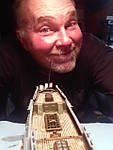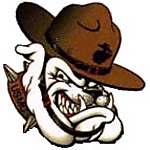This is a kind of follow-up to a couple of topics that lon started. I'm wondering what are the factors you consider when deciding whether or not to open up molded-in limber holes. Sure, the number of holes could be an issue and the fact that opening them might require some sort of backing to prevent the see-through problem, but are there other things to consider? Do the open holes just not look right at some scales? Are there some holes (for example, those on plated decking) too small to deal with even though they are within "drillable" size ( #80 drill is about right for a 2" hole at 1/144 scale).
I'd think that open holes, if done carefully, would always appear more realistic than painted depressions in the plastic, but my experience is pretty limited. What do you accomplished modelers do?
You are viewing the archived version of the site.
Go to modelshipwrights.com for the current dynamic site!
Go to modelshipwrights.com for the current dynamic site!
Hosted by Jim Starkweather
Limber (drain) holes - to open or not?
DrDull

Joined: February 23, 2006
KitMaker: 133 posts
Model Shipwrights: 128 posts

Posted: Monday, March 20, 2006 - 09:17 PM UTC
Posted: Monday, March 20, 2006 - 09:36 PM UTC
I don't qualify as an accomplished modeler, but I vote for drilling them out. Drilled out, they just seem to have the right look of darkness that I can't acheive with paints, washes or highlights.
That said, if you get a chance to see Paul Boyer's 1/72 Academy SB2D Hell Diver that was in FSM a couple of issues back, look at the 'holes' in the dive brakes. They're just molded dimples, but, Paul did a red wash of some sort that makes them look real!
That said, if you get a chance to see Paul Boyer's 1/72 Academy SB2D Hell Diver that was in FSM a couple of issues back, look at the 'holes' in the dive brakes. They're just molded dimples, but, Paul did a red wash of some sort that makes them look real!

Posted: Monday, March 20, 2006 - 09:55 PM UTC
Hi Barry
This is a very good question and I must say that I have a fair amount of subs under my belt and I can say that drilling the limber holes in my subs depend on:
- Scale (1/35 and 1/72): in these scales and when possible I'll try to make the limber holes drilled/perfurated. If there's a AM part it makes it easyer (as with Revell Typ VII-C). On scales smaller than these, I'll drill the most proemenent and bigger ones. On my USS Bluefish I had to sand away the ones marked in the model and recribe and drill part of them in the correct shape (but I didn't went all the way trough!)
- Medium (Resin or Plastic): I like to work in Resin, but in some cases it makes impossible to drill the holes in a good fashion - all you can do is drill them deeper into the resin chunk.
- Effect: I must say that drilled limber holes, or portholes or whatever we are talking about, always makes a more realistical effect than just painted, shaded ones. It is a question of planning and the amount of work you are willing to make (and again.. the medium of the model)
But I have to say that it realy makes the difference on what model we are talking about.
As an example, in a very small scale as it is 1/700, on my JAG Forrest Sherman DD, I didn't drilled the portholes. On my current project, a USS Arizona I did. And although it is a tedious task, the effect is very visible and it makes a good improvement
Skipper
This is a very good question and I must say that I have a fair amount of subs under my belt and I can say that drilling the limber holes in my subs depend on:
- Scale (1/35 and 1/72): in these scales and when possible I'll try to make the limber holes drilled/perfurated. If there's a AM part it makes it easyer (as with Revell Typ VII-C). On scales smaller than these, I'll drill the most proemenent and bigger ones. On my USS Bluefish I had to sand away the ones marked in the model and recribe and drill part of them in the correct shape (but I didn't went all the way trough!)
- Medium (Resin or Plastic): I like to work in Resin, but in some cases it makes impossible to drill the holes in a good fashion - all you can do is drill them deeper into the resin chunk.
- Effect: I must say that drilled limber holes, or portholes or whatever we are talking about, always makes a more realistical effect than just painted, shaded ones. It is a question of planning and the amount of work you are willing to make (and again.. the medium of the model)
But I have to say that it realy makes the difference on what model we are talking about.
As an example, in a very small scale as it is 1/700, on my JAG Forrest Sherman DD, I didn't drilled the portholes. On my current project, a USS Arizona I did. And although it is a tedious task, the effect is very visible and it makes a good improvement
Skipper

madwolf

Joined: February 20, 2006
KitMaker: 258 posts
Model Shipwrights: 141 posts

Posted: Monday, March 20, 2006 - 10:39 PM UTC
Barry,
My XXIII was the second attempt at drilling out the flood holes. I used my first build, the U-505 (IXC) to test out the drilling of the larger holes. I must say I really like the idea of drilled out holes, however, they take forever to do right and it's very easy to ruin your job if the proximity of the holes is very close. (I'm talking about the grill-style holes) On my 1/144 XXIII some of these holes are separated by about a 0.25 mm and I ended up braking the wall between them several times. I repaired it with liquid putty, but you have to be extremely careful with it as well. I will continue to drill out larger holes in the future and as skipper mentioned, I will definetely drill out all of them on larger scale models such as the 1/72. Actually, scratch that. I plan to use modelbrass' PE set for that.
I guess it all boils down to how detailed you want to get, how much time you have and most importantly, how much patience.
My XXIII was the second attempt at drilling out the flood holes. I used my first build, the U-505 (IXC) to test out the drilling of the larger holes. I must say I really like the idea of drilled out holes, however, they take forever to do right and it's very easy to ruin your job if the proximity of the holes is very close. (I'm talking about the grill-style holes) On my 1/144 XXIII some of these holes are separated by about a 0.25 mm and I ended up braking the wall between them several times. I repaired it with liquid putty, but you have to be extremely careful with it as well. I will continue to drill out larger holes in the future and as skipper mentioned, I will definetely drill out all of them on larger scale models such as the 1/72. Actually, scratch that. I plan to use modelbrass' PE set for that.

I guess it all boils down to how detailed you want to get, how much time you have and most importantly, how much patience.
blaster76

Joined: September 15, 2002
KitMaker: 8,985 posts
Model Shipwrights: 3,509 posts

Posted: Tuesday, March 21, 2006 - 01:38 AM UTC
I would go with a lot of what skipper says. I built a 72nd scale Type VII and drilled the holes out. However, I have a 350 scale Type XXI I plan to build and wouldn't even consider drilling those out. It is a very tedious and stressful job. There are so many to drill out and you have to be very percise on each and every one . You could ruin or damage the part you are drilling into.
Posted: Tuesday, March 21, 2006 - 02:06 AM UTC
Ion,
I'm not familiar with
I'm not familiar with
Quoted Text
that you're talking about. But if it's a grill work, could you cut out the whole "grill" area and replace it with woven brass mesh or PE? K&S sells different grid brass sheets and somewhere I picked up a very fine mesh from one of the railroad suppliers.(I'm talking about the grill-style holes)
DrDull

Joined: February 23, 2006
KitMaker: 133 posts
Model Shipwrights: 128 posts

Posted: Tuesday, March 21, 2006 - 05:34 AM UTC
Thanks for the comments, guys. I drilled out all the superstructure holes on the 1/178 Lionfish conversion I did, but I'm not sure I would have done the same if the boat I was modeling wasn't one that followed the Electric Boat pattern rather than the Portsmouth one. I was thinking about this issue as I was getting ready for my first DDD2 build - I live a few blocks from the U-505 and am going to start with the 1/200 Nichimo Type IXC - I specifically looked for all the openings in the hull last time I visited the museum - there are a lot more than I'd noticed before and its going to be an interesting challenge to translate them onto the model.
Barry
Barry

95bravo

Joined: November 18, 2003
KitMaker: 2,242 posts
Model Shipwrights: 1,064 posts

Posted: Monday, April 24, 2006 - 07:45 PM UTC
As usual...I'm late to the party, but I 'll add my two cents and supply a comment.
Drill 'em.
You'll be glad that you did.
Drill 'em.

You'll be glad that you did.

Frigate

Joined: April 22, 2006
KitMaker: 500 posts
Model Shipwrights: 205 posts

Posted: Monday, April 24, 2006 - 08:25 PM UTC
Gents:
This is always an interesting question with Sub models. I'd like to mention another possible method for modelers to think about. Granted, it depends on the scale and molding of the model your working. With my modeling, 1/144th scale and below, I do not open the limber holes. I normally paint with acrylic paints. Once the main colors are on, i make extensive use of artist's designers gouache. This product is available in just about all art supply stores, and comes in tubes. It is used by watering in down, and just painting the limber holes,deck scribing, etc. Let the product dry, normally takes about 5 minutes. Then take a damp q-tip, and start removing. This actually has several added features. It will fill in the lower areas, plus you can streak the color to show exhaust, stain runs, etc. The gouache is available in several colors. This is great for replicating rust, drain areas, etc. Another benefit is the time it takes to accomplish the task. With this product, I can highlight a small sub (1/350) in about an hour. And depending how much one experiments with color and tone, it really brings the model to life without the AMS headaches ! Just an idea for all to consider....Enjoy !
This is always an interesting question with Sub models. I'd like to mention another possible method for modelers to think about. Granted, it depends on the scale and molding of the model your working. With my modeling, 1/144th scale and below, I do not open the limber holes. I normally paint with acrylic paints. Once the main colors are on, i make extensive use of artist's designers gouache. This product is available in just about all art supply stores, and comes in tubes. It is used by watering in down, and just painting the limber holes,deck scribing, etc. Let the product dry, normally takes about 5 minutes. Then take a damp q-tip, and start removing. This actually has several added features. It will fill in the lower areas, plus you can streak the color to show exhaust, stain runs, etc. The gouache is available in several colors. This is great for replicating rust, drain areas, etc. Another benefit is the time it takes to accomplish the task. With this product, I can highlight a small sub (1/350) in about an hour. And depending how much one experiments with color and tone, it really brings the model to life without the AMS headaches ! Just an idea for all to consider....Enjoy !

 |
















